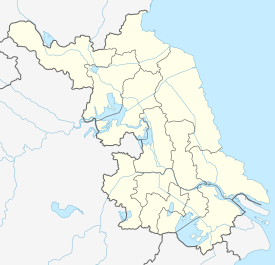Jiangyin
Jiangyin (simplified Chinese: 江阴; traditional Chinese: 江陰; pinyin: Jiāngyīn; Wade–Giles: Chiangyin, Jiangyin dialect: [kɐ̞ŋ.jɪŋ]) is a county-level city on the southern bank of the Yangtze River, and is administered by Wuxi, Jiangsu province. Jiangyin is one of the most important transport hubs on the Yangtze River, it is also one of the most developed counties in China.
Jiangyin 江阴市 Kiangyin | |
|---|---|
 | |
 Jiangyin Location within Jiangsu | |
| Coordinates: 31°50′20″N 120°17′42″E | |
| Country | People's Republic of China |
| Province | Jiangsu |
| Prefecture-level city | Wuxi |
| Government | |
| • Party Secretary | Chen Jinhu (陈金虎) |
| • Mayor | Cai Yeming (蔡叶明) |
| Population (2010 census) | |
| • County-level city | 1,595,138 |
| • Urban | 1,595,138 |
| • Metro | 3,526,260 |
| Time zone | UTC+8 (China Standard Time) |
| Postal code | 214400 |
| Area code(s) | 0510 |
| License plates prefix | 苏B |
| Website | www |
Etymology
Jiangyin's name means "River Shade", from its location on the south or shady side of the Yangtze River.
History

Jiangyin was a township of Yanling (延陵; later known as Piling, 毗陵) county initially. Since the township was located in the north of Ji Lake, it was given the name "Jiyang" (暨陽). In 281, it was promoted as a county of Piling commandery. In 558, the north-west part was taken away from then Lanling county (Wujin and its around areas) to create Jiangyin county. It was served as the seat of Jiangyin commandery, of which jurisdiction equating to the modern city's, until the commandery was dissolved in 589. It was elevated to jun (military prefecture) status during Southern Tang, until being restored as a county of Changzhou in 1071. It developed as an important port for overseas trades, and a Maritime Trade Supervisorate (市舶提擧司) was established to manage in 1145. The county became a zhou (smaller prefecture) during Yuan dynasty, but was reduced to county status again in 1367.[1]
In 1472, the sandbank in the Yangtze River was independent from the county to establish Jingjiang county.[2] In 1645, the draconian enforcement of the decree adopting the Manchu hair style and dress inflamed the local Han Chinese people's spirit to resist. Since the ultimatum "either lose your hair or lose your head" was given, they held the walled city against Qing sieges under a magistrate Yan Yingyuan (閻應元) 's leadership.[3]
On 23 April 1987, Jiangyin was approved by the State Council of China to become a county-level city.[4]
Transport
Climate
| Climate data for Jiangyin (normal temperatures: 1957−1987, extremes and precipitations: 1957−2014) | |||||||||||||
|---|---|---|---|---|---|---|---|---|---|---|---|---|---|
| Month | Jan | Feb | Mar | Apr | May | Jun | Jul | Aug | Sep | Oct | Nov | Dec | Year |
| Record high °C (°F) | 20.8 (69.4) |
26.8 (80.2) |
30.4 (86.7) |
34.3 (93.7) |
36.3 (97.3) |
38.2 (100.8) |
39.6 (103.3) |
41.3 (106.3) |
37.8 (100.0) |
33.3 (91.9) |
28.8 (83.8) |
23.2 (73.8) |
41.3 (106.3) |
| Average high °C (°F) | 6.1 (43.0) |
9.0 (48.2) |
12.5 (54.5) |
17.9 (64.2) |
23.2 (73.8) |
27.2 (81.0) |
32.0 (89.6) |
31.5 (88.7) |
25.6 (78.1) |
21.1 (70.0) |
15.7 (60.3) |
7.9 (46.2) |
19.1 (66.4) |
| Daily mean °C (°F) | 3.0 (37.4) |
4.6 (40.3) |
8.9 (48.0) |
14.7 (58.5) |
20.1 (68.2) |
24.2 (75.6) |
28.1 (82.6) |
27.7 (81.9) |
23.3 (73.9) |
17.8 (64.0) |
11.8 (53.2) |
5.4 (41.7) |
15.8 (60.4) |
| Average low °C (°F) | −0.2 (31.6) |
0.7 (33.3) |
5.5 (41.9) |
12.1 (53.8) |
17.7 (63.9) |
22.1 (71.8) |
25.4 (77.7) |
24.3 (75.7) |
20.6 (69.1) |
15.1 (59.2) |
7.7 (45.9) |
0.5 (32.9) |
12.6 (54.7) |
| Record low °C (°F) | −14.2 (6.4) |
−11.4 (11.5) |
−7.5 (18.5) |
−1.0 (30.2) |
3.8 (38.8) |
11.7 (53.1) |
15.5 (59.9) |
17.1 (62.8) |
9.3 (48.7) |
1.3 (34.3) |
−4.6 (23.7) |
−10 (14) |
−14.2 (6.4) |
| Average precipitation mm (inches) | 42.3 (1.67) |
53.2 (2.09) |
74.3 (2.93) |
84.0 (3.31) |
98.0 (3.86) |
172.1 (6.78) |
186.7 (7.35) |
150.7 (5.93) |
95.3 (3.75) |
57.4 (2.26) |
52.4 (2.06) |
32.0 (1.26) |
1,098.4 (43.25) |
| Mean monthly sunshine hours | 140.2 | 128.8 | 151.5 | 168.8 | 186.2 | 163.0 | 210.7 | 220.4 | 171.5 | 180.1 | 153.5 | 154.3 | 2,029 |
| Source: Jiangyin Municipal Chorography & Annual of Jiangyin, 2016 [7][8] | |||||||||||||
Notable people
- Xu Xiake (1587–1641) - noted traveller and geographer
- Liu Bannong (1891–1934) - writer
- Liu Tianhua (1895–1932) - musician and composer
- Miao Quansun (缪荃孙) (1844–1919) - Academic, catalog writer, bibliophile, founder of modern Chinese librarianship
- Shangguan Yunzhu - movie star
- Yu Minhong - Chairman and President of New Oriental Education & Technology Group
Notes
- 中国历史大辞典·历史地理卷 [The Great Encyclopaedia of Chinese History, Volume on Historical Geography] (in Chinese). Shanghai Cishu Press. 1996. pp. 350–1. ISBN 7-5326-0299-0.
- Cheng (1992), p. 14.
- Cheng (1992), p. 15.
- Cheng (1992), p. 1383.
- "新长车务段多管齐下确保轮渡运输安全". www.peoplerail.com. Retrieved 2017-06-18.
- "New high-speed line to join Shanghai, Nanjing". www.chinadaily.com.cn. 2017-06-17. Retrieved 2018-09-06.
- Cheng (1992), p. 135.
- "气候概况".
References
- Cheng, Yizheng (1992). Jiangyin Municipal Chorography. Shanghai People's Publishing House. ISBN 7-208-01458-2.CS1 maint: ref=harv (link)